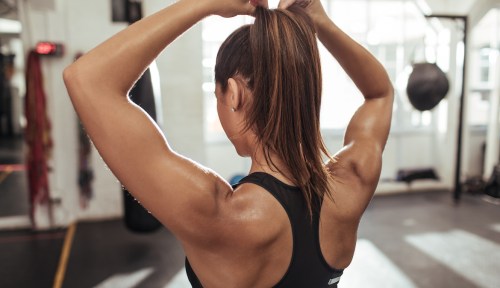Why Batwings Can Be a Secret Weapon To Strengthen Your Back, Shoulders, and Upper Arms
Why the batwing exercise can shore up your posterior chain by strengthening your upper back, shoulders, and triceps.

When you hear someone mention “batwings” in the gym, you might assume they’re making a demeaning reference to someone’s upper arms. But the term is also the name for one of the most effective bodyweight exercises you can do.
Experts in This Article
What is it? Lying down on your back with your elbows at your sides, you put your weight in your elbows to raise your chest and head off the ground.
It’s that simple. And it targets several muscles along the backside of your body: the rhomboids (upper back), trapezius (lower back), latissimus dorsi (side of back), rear deltoids (shoulders), and triceps (upper arms), plus your core. Talk about getting a solid return for your time spent under tension.
This is especially useful because, in a world where most of us focus more on the muscles at the front of our body, our posterior chain often gets neglected. “We do a lot of exercises on the front muscles of our body, largely because that’s the most common direction we move and because that’s what we see when we look in the mirror,” says Danica Osborn, a certified personal trainer and LifeTime group training coach. “However, to promote better posture, reduce muscular imbalances, prevent back pain, and optimize athletic performance, we have to be careful not to overlook our posterior chain.”
The best way to work batwings into your workout repertoire is to work in a few different variations of the move. This not only spices things up but keeps your muscles on their toes: You create a new stimulus by switching up the exact movements, causing muscle adaptations and progression over time. Variety can also help prevent overuse injuries. Here are four batwing variations that Osborn suggests putting into regular rotation if you have access to equipment like resistance bands, TRX straps, and a cable machine.
Try these batwing variations
Osborn recommends performing three sets of 10 reps for each of these.
Standard batwing
- 1.Lay flat on your back.
- 2.Pressing into your elbows, lift your shoulders and head off the mat. Keep your chin lifted away from your chest and roll your shoulders back and down. Make sure your heels remain on the floor.
- 3.Pause for one to two seconds at the top before slowly returning to the starting position.
“If you notice your abdominal muscles flaring as you crunch up in a batwing, a great way to modify this movement is to lift your feet off the floor and hinge your knees at a 90-degree angle,” Osborn says.
V-sit resistance band pulldown
- 1.Loop a resistance band around a pull-up bar or another secure structure.
- 2.Grab each end of the resistance band, then sit down in a V-position (legs off the floor) below it.
- 3.Pull the band toward you while remaining in the V-position.
- 4.Pause for one to two seconds before returning to the starting position.
TRX high row
- 1.Grab the TRX handles and lean back while keeping your back and legs straight and heels firmly planted on the ground. Hold the handles with palms facing down.
- 2.Pull yourself up toward the cables, with your elbows in line with your shoulders.
- 3.Pause for one to two seconds before slowly lowering back to the starting position.
“To decrease the intensity of this move, walk your legs back,” explains Osborn. “That way, the TRX cables bear less weight as you row.”
Seated lat pulldown
- 1.Set a cable to the highest position before sitting or kneeling on the ground. Use a rope cable attachment that you can grasp with both hands.
- 2.Grab the rope then sit down in a reclined V-position with your feet and glutes on the floor.
- 3.Pull the rope toward your chest while directing your elbows back and down.
- 4.Pause for one to two seconds before carefully returning to the starting position.
Sign Up for Our Daily Newsletter
Get all the latest in wellness, trends, food, fitness, beauty, and more delivered right to your inbox.
Got it, you've been added to our email list.










